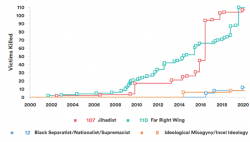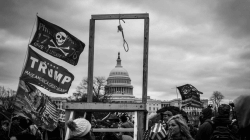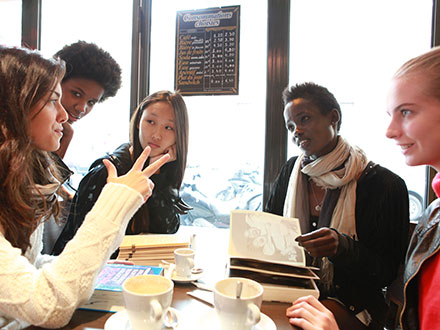Tackling Hate in the Homeland: US Radical Right Narratives and Counter-Narratives at a Time of Renewed Anti-Government Extremism
by William Allchorn
Over the past few years, North America, particularly the US, has become a focal point for practitioners and researchers studying the radical right.
Given a five-fold rise in white supremacist violence since 2009 (see figure 1 below), researchers and policymakers are more aware of the urgency of the threat posed by radical right violent extremism, as reflected in a shift in priorities away from an overwhelming focus upon religiously inspired extremism to Racially and Ethnically Motivated Violent Extremism and Domestic Terrorism.
This troubling picture has also been compounded by the rise of transnational, digitally anchored, radical right ‘accelerationist’ organisations (such as Atomwaffen Division and the Base), the events of ‘Unite the Right’ at Charlottesville in August 2017 and the recent storming of the US Capitol– the event that led the Government of Canada to designate several radical right groups including the Atomwaffen Division, the Base, and the Proud Boys as terrorist organisations in February 2021.[1] Indeed, it was the events of January 6, 2021, that (again) pulled into sharp focus for US political elites and law enforcement agencies the risk of radical right inspired anti-government extremism and violence, infiltration of such agencies by anti-government extremist ideologies, as well as the broader difficulties of popular conspiracy theories acting as a “radicalisation multiplier” toward superficially spontaneous acts of mob violence.[2]

Figure 1: US Terror Attacks by Ideology of Perpetrator, 2000-2020
Source: New America Foundation[3]
Radical Right Extremist Groups and Narratives in the US: Ascendant Chauvinism & Accelerationism, Persistent White Supremacism, and Anti-Government Extremism
In the most recent country report for the CARR-Hedayah Radical Right Counter-Narratives (RRCN) project, we researched 28 of the US’s key radical right extremist groups and the violent and ideological narratives that they have propagated over the past six years. Moving from cell-based neo-Nazis through mass protest and into anti-government militias, the report uncovered a concerning overlap between ideologically distinct groups when it came to narratives of anti-government revolution and violence that have been bounded around in the US context for several years. In 2015, for example, the founder of the Oath Keepers infamously declared that: “John [Mc]Cain is a traitor to the Constitution… He would deny you the right for trial to jury, but we would give him a trial by jury. Then after we convict him he should be hung by the neck until dead.”[4] Moreover, ‘sovereign-citizens’ conspiracy theories have become a normal part of the rhetoric in such circles for several decades – with the newest expressions of such groups like the Three Percenters founded on crisis narratives that the government wishes to forcibly take away the firearms of ordinary citizens.
In addition, organised radical right extremist groups and non-aligned individuals have recently united around a QAnon-based narrative that Donald Trump was fighting a satanic pedophile ring set up by Democratic elites – with one so-called ‘Q Drop’ describing Democrats as “PURE EVIL. HOW MANY IN WASHINGTON AND THOSE AROUND THE WORLD (IN POWER) WORSHIP THE DEVIL?”[5] The newest policy challenges in the coming years will therefore be to pierce the echo chambers of polarisation online with psycho-social support messages that sow a ‘seed of doubt’ among ‘Q’ adherents, and to use counter-narratives outlining the falsity and dangers of adhering to anti-government conspiracy theories in preventing average citizens, veterans, and law enforcement officers from being sucked into the US’s organised militia movement going forward.[6]

Image 1: Representation of Oath Keeper Uniform at 6 January 2021 Capitol Riot
Source: CNN Photo Illustrations by Priya Krishnakumar, CNN https://www.cbs58.com/news/decoding-the-extremist-symbols-and-groups-at-the-capitol-hill-insurrection
Another finding that the US country report on RRCN also highlighted is the existence of several cell-based, ‘fight club’-type groups (e.g. FOAK, the Base and Proud Boys), with the Proud Boys in particular involved in anti-government rallies after the 2020 Presidential election. Pushing chauvinist and white victimhood narratives, such street-based expressions of anti-government sentiment by the Proud Boys have become more problematic in recent years, with several violent incidents, including the group’s appearance at ‘Stop the Steal’ rallies, targeted assaults on anti-fascist activists in New York[7], and fights with left-wing counter-protestors in Oregon,[8] leading to the group being listed as an “extremist group with ties to white nationalism” by the FBI.[9] Established in September 2016 by Vice Media cofounder Gavin McInnes, McInnes attempted to distance the group from the white-supremacist movement in 2017.[10]
Yet – even under new leadership more recently– this has not staved off controversy for a group once described by the Southern Poverty Law Centre as an “alt-right fight club.”[11] This is steeped in the Proud Boy’s group masculinist discourse and narratives – with one excerpt from a Proud Boys USA blog for the RRCN US Report, suggesting: “So Proud Boys, this is a call to arms. You can choose to be a soft, weak, useless male. Or you can embrace the struggle and make yourself mentally and physically tough.”[12] The group itself also typifies a nasty trend towards street-based violence (including the Boogaloo movement)[13] that we have seen between radical right extremist and left-wing activists in many of the cities and towns across the US over the past two years.[14] De-escalating this dynamic of conflict and countering the masculinist appeals of US radical right extremist groups will be a key challenge going forward.

Image 2: Enrique Tarrio, leader of the far-right group the Proud Boys leader during a march into Freedom Plaza, in Washington DC on 12 December 2020.
Source: Gamal Diab/EPA https://www.theguardian.com/us-news/2021/jan/27/proud-boys-leader-enrique-tarrio-fbi-informant
Adding to this, we have found several US groups that have a strong bearing on the radical right’s international cultural milieu, with more historic organisations like the National Alliance and Creativity Movement transmitting fictional and neo-paganist imaginaries of white supremacist, ‘racially pure’ futures, across borders. In particular, a strand of neo-Nazism spiritualism and Satanism has been acting as a touchpoint for other ex-Iron March outfits (e,g. Atomwaffen Division in the US, Antipodean Resistance in Australia and National Action in the UK); this continues to mutate and spread to the globe and can be found as far away as New Zealand.[15] Engaged in cultish rituals, members of such ‘alt-spirituality’ groups in the UK have been variously accused of paedophilia, rape, and animal sacrifice.[16]
Equally concerning, the US RRCN report also found that the National Alliance’s influence on organised and solo-actor violence within the US radical right extremist scene continued to have pertinence. In particular, the report notes how NA’s founder, William Pierce’s, 1978 and 1989 book The Turner Diaries and Hunter lives on as an inspiration to white supremacists and neo-Nazi terrorists around the world. Indeed, its overtures to white supremacist revolution that inspired Timothy McVeigh and a significant section of the recent Capitol rioters – with a set of gallows erected at the site of the January 6, 2021 ‘Stop the Steal’ Rally and reminiscent of the “day of the rope” depicted in McVeigh’s 1978 novel where a set of murders are performed against so-called “race traitors” such as journalists, politicians, and women who were in relationships with non-white men.[17]

Image 3: Trump supporters near the U.S Capitol, on January 06, 2021, in Washington, DC.
Source: Nurphoto via Getty Images, https://www.forbes.com/sites/tommybeer/2021/01/15/report-capitol-mob-came-within-100-feet-of-pence/?sh=6fbbc0be18e6
Countering Radical Right Extremist Violence in the United States: Online Conspiracy Theories, ‘Dark Social’ and the Quest for Clearer CVE Programming
One of the galvanising effects of the Capitol Riots has been what some have prematurely described as a ‘9/11’ moment in the minds of scholars and practitioners engaged in studying and countering radical right extremism in the US.[18] Indeed, the 45th President Joe Biden specifically referred to this in his inauguration speech (“And now a rise of political extremism, white supremacy, domestic terrorism that we must confront and we will defeat”) and announced initiatives (e.g. a comprehensive threat assessment, coordinating intelligence sharing, disrupting networks, trying to prevent radicalization) has shown it as a key priority of his administration.[19] While this is a a much needed step, there are several gaps in Countering Violent Extremism (CVE) practice in the US context when it comes to radical right extremism that needs filling in order to de-escalate the dynamic of violence that we are at this moment in time.
One of those key gaps, identified in the US RRCN report, that needs to be filled going forward are counter-narrative campaigns that debunk online, anti-government conspiracy theories. Here, it is important to note that there have already been a number of programmes that have attempted to do this. In particular, the approaches undertaken by EXIT USA, the Institute for Strategic Dialogue, and Free Radical’s Project provide counter-narrative videos and infographics that refer individuals to de-radicalization experts.[20] It is recommended that more be done to fund these sort of grassroots projects, as well as intervention providers to interact with sympathetic individuals. Moreover, it may be useful to operationalise alternative narratives targeted at downstream individuals on top of counter-narratives for upstream individuals as a way of diverting them away from extremist content. According to independent assessments of correction, debiasing, and counter-narrative techniques, such approaches are likely to yield the highest level of sustained impact on cell-based and self-radicalising individuals based in the most clandestine spaces of alt-tech social media platforms, digesting some of the most toxic, self-sealing conspiracy theories out there. [21]
Another key gap in CVE responses is the lack of concerted efforts to reduce the availability of ideological material online that can serve as radicalising content for organised and spontaneous manifestations of radical right extremist violence. While first amendment rights and civil liberties of individuals should be preserved, the availability of The Turner Diaries and other fringe apocalyptic threat literature (including Siege culture) only help to knit together a culture of extremism that reduces the moral barriers to violence within closed online communities.[22] Added to this is the role of dark social media companies (such as Telegram and Discord) in reducing the availability of such content and the de-platforming of ideologues who might inspire further insurrectionist violence in a tailored way that does not invoke the further hardening of extremist identities looks to be a key way forward.
A final gap is the terminological and legal barriers to dealing with the extreme right-wing terrorist threat. Neologisms, such as Domestic Terrorism and Racially and Ethnically Motivated Violent Extremism, do a lot to mask the real target of radical right extremist counter-terrorism initiatives in the US. Like in academia, clouded CVE thinking can build up when the threat is not defined properly. A more open discussion of the uncomfortable mainstreamness of radical right extremist ideology within Western societies and the causes of its violent manifestations would go a long way in dealing with such a threat and would provide clear thinking on the matter.
Conclusions and Recommendations
Going forward, therefore, US CVE initiatives tackling radical right extremist violence need to be placed on a more sustained footing. This can be done by extending already-established funding cycles and increasing the number of programmes that look at different facets of the problem. It can also be done through harnessing the power of online platforms to reduce the accessibility of content and the ability of learning algorithms to identify and target individuals in the process of radicalising in order to intervene early on and provide bespoke counter-narrative content to those individuals. At a broader societal level, campaigns like the US State Department backed “2011 Hours Against Hate” and “Know Extremism” programmes will also serve a role in inoculating individuals in the future.[23] When it comes to these broader-based counter-narratives themselves, therefore, it will involve: 1) using the right elite messengers with mass appeal (e.g. celebrities and sports figures) in order to cut through to non-radical right aligned audiences and 2) using informal (i.e. citizens), tech-savvy individuals (i.e. students) to conduct higher impact campaigns, with a far greater organic reach as a result.
By building extra for research, better capacity for interventions and programmes needed to deliver alternative narratives directly to individuals vulnerable to or in the early stages of radicalisation, the United States will do better in inhibiting the spread of violence within the radical right extremist scene and inoculating citizens from engaging in such activism in the first place, acting to reduce the physical and social harms of extremism from above and below in a pincer-like movement and therefore de-escalating the dynamic of violence that has grown up in this space over the past several years.
References
[1] The August 2017 Unite the Right Rally and January 2021 Capitol Riots were two key recent turning points in public expressions of radical right extra-parliamentary unity and violence in the US. For more information on the Unite the Right Rally and Capitol Riots, see: Keneally, M., ‘What to know about the violent Charlottesville protests and anniversary rallies’, ABC News, 8 August 2018, online at: https://abcnews.go.com/US/happen-charlottesville-protest-anniversary-weekend/story?id=57107500 & Riley-Smith, B. , Sabur, R, & Allen, N., ‘Donald Trump’s supporters storm Washington: Everything we know about the US Capitol riots’, The Daily Telegraph, 11 February 2021, online at: https://www.telegraph.co.uk/news/0/us-capitol-riot-trump-supporters-2021-protest-what-happened-died/.
[2] Emberland, T., “Why conspiracy theories can act as radicalization multipliers of far-right ideals”, C-REX Right Now! Blog, 24 February 2020, online at: https://www.sv.uio.no/c-rex/english/news-and-events/right-now/2020/conspiracy-theories-radicalization-multipliers.html.
[3] Peter Bergen et al., “Terrorism in America After 9/11,” New America Foundation, online at: www.newamerica.org/in-depth/terrorism-in-america/what-threat-united-states-today/.
[4] Southern Poverty Law Centre, ‘Oath Keepers’, Extremist Files, online at: https://www.splcenter.org/fighting-hate/extremist-files/group/oath-keepers.
[5] For more see: Argentino, Marc-André, ‘QAnon and the storm of the U.S. Capitol: The offline effect of online conspiracy theories’, The Conversation, 7 January 2021, online at: https://theconversation.com/qanon-and-the-storm-of-the-u-s-capitol-the-offline-effect-of-online-conspiracy-theories-152815; Bellaiche, J., ‘Assessing the Threat of QAnon Violence’, GNET Insight Blog, 15 July 2020, https://gnet-research.org/2020/06/15/assessing-the-threat-of-qanon-violence/; The Economist, ‘Republicans face a choice between Donald Trump and reality’, Lexington, 28 January 2021, online at: https://www.economist.com/united-states/2021/01/28/republicans-face-a-choice-between-donald-trump-and-reality; & Thomas, P,. ‘How QAnon uses satanic rhetoric to set up a narrative of ‘good vs. evil’’, The Conversation, 20 October 2020, online at: https://theconversation.com/how-qanon-uses-satanic-rhetoric-to-set-up-a-narrative-of-good-vs-evil-146281.
[6] Perliger, A., ‘Deciphering the Second Wave of the American Militia Movement’, CARR Policy Insight, London: Centre for the Analysis of the Radical Right, online at: https://usercontent.one/wp/www.radicalrightanalysis.com/wp-content/uploads/2021/01/Perliger-2021-CARR-Policy-Insight.pdf.
[7] Reinstein, J., ‘Two Proud Boys Have Been Sentenced To Prison For Their Brutal New York City Assault’, BuzzFeed News, 22 October 2019, online at: www.buzzfeednews.com/article/juliareinstein/proud-boys-sentenced-prison-new-york-city-assault-gavin.
[8] Wilson, J., ‘Who are the Proud Boys, ‘western chauvinists’ involved in political violence?’, The Guardian, 14 July 2018, online at: www.theguardian.com/world/2018/jul/14/proud-boys-far-right-portland-oregon.
[9] Wilson, J., ‘FBI now classifies far-right Proud Boys as ‘extremist group’, documents say’, The Guardian, 19 November 2018, online at: www.theguardian.com/world/2018/nov/19/proud-boys-fbi-classification-extremist-group-white-nationalism-report.
[10] This move was mainly to avert accusations of racism and controversies surrounding its involvement at the Charlottesville ‘Unite the Right’ rally in August 2017. See: Woodhouse, L.A., ‘After Charlottesville, the American Far Right is Tearing Itself Apart’, The Intercept, 21 September 2017, online at: https://theintercept.com/2017/09/21/gavin-mcinnes-alt-right-proud-boys-richard-spencer-charlottesville/.
[11] Morlin, B., ‘New “Fight Club” Ready for Street Violence’, Southern Poverty Law Centre, online at: www.splcenter.org/hatewatch/2017/04/25/new-fight-club-ready-street-violence.
[12] Judy, C., ‘Proud Boys Weekly Workout #1’, Proud Boys website, online at: https://officialproudboys.com/sports-talk/proud-boys-weekly-workout-1/
[13] Bellingcat, ‘The Boogaloo Movement Is Not What You Think’, 27 May 2020, online at: https://www.bellingcat.com/news/2020/05/27/the-boogaloo-movement-is-not-what-you-think/.
[14] GT staff reporters, ‘Growing social division, far-left and far-right confrontation underlying cause for unrest: experts’, Global Times, 2 June 2020, online at: https://www.globaltimes.cn/content/1190326.shtml.
[15] For a more in-depth look at these movements, see: Goodrick-Clarke, N, Black Sun: Aryan Cults, Esoteric Nazism, and the Politics of Identity. New York: New York University Press, 2003.
[16] Lowles, N., ‘Order of the Nine Angles’, Hope Not Hate Website, 16 February 2019, online at: https://www.hopenothate.org.uk/2019/02/16/state-of-hate-2019-order-of-nine-angles/ & Subcomandante X, ‘[Brief] New Sonnenkrieg Division Propaganda Shared on Fascist Forge’, The Medium, 16 January 2019, online at: https://medium.com/americanodyssey/new-sonnenkrieg-division-propaganda-appears-on-fascist-forge-forum-bb488cefbe53.
[17] ADL, ‘Day of the Rope’, Hate Slogans/Slang Term Library, online at: https://www.adl.org/education/references/hate-symbols/day-of-the-rope.
[18] Hulse, T., ‘Congress United After 9/11, but 1/6 Has Deepened the Divide’, New York Times, 12 January 2021, online at: https://www.nytimes.com/2021/01/12/us/politics/capitol-republicans-democrats.html.
[19] Mudde, C., ‘Far-right extremism in the US is deadly serious. What will Biden do about it?’, The Guardian, 27 January 2021, online at: https://www.theguardian.com/commentisfree/2021/jan/27/far-right-extremism-us-terror-biden.
[20] Counter-Narrative Toolkit, ‘Exit USA’ Case Study, online at: www.counternarratives.org/html/case-studies-entry?id=17; Frenett, R. & Dow, M, ‘One to One Online Interventions: A Pilot CVE Methodology’, London & Perth: ISD & Curtin University, 2016, online at: www.isdglobal.org/wp-content/uploads/2016/04/One2One_Web_v9; & Free Radicals, ‘We are Free Radicals’ Website, 2019, online at: https://web.archive.org/web/20190809043606/http://wearefreeradicals.net/index.html
[21] See: Cook, J. & Lewandowsky, S. (2011) ‘The Debunking Handbook’ St. Lucia, Australia: University of Queensland, online at: http://sks.to/debunk; Dafnos, A., ‘Narratives as a Means of Countering the Radical Right; Looking into the Trojan T-shirt Project.’, Journal EXIT Deutschland, 2014, online at: http://journals.sfu.ca/jed/index.php/jex/article/view/98; Lewandowsky, S. (2012) ‘Misinformation and Its Correction: Continued Influence and Successful Debiasing.’ Psychological Science in the Public Interest, 13(3), 106-131; & Silverman, T., Stewart, C.J., Amanullah, Z., & Birdwell, J., ‘The Impact of Counter-Narratives’, London: ISD Global, 2016, online at: https://www.isdglobal.org/wp-content/uploads/2016/08/Impact-of-Counter-Narratives_ONLINE_1.pdf
[22] Macklin, G., ‘The El Paso Terrorist Attack: The Chain Reaction of Global Right-Wing Terror’, CTC Sentinel, December 2019, online at: https://ctc.usma.edu/app/uploads/2019/12/CTC-SENTINEL-112019.pdf.
[23] See: Braddock, K., ‘Vaccinating Against Hate: Using Attitudinal Inoculation to Confer Resistance to Persuasion by Extremist Propaganda’, Terrorism and Political Violence, 2019, https://doi.org/10.1080/09546553.2019.1693370.
About Hedayah's Blog Series
Hedayah publishes a monthly blog series covering a range of different topics related to counter violent extremism (CVE). These blogs highlight the latest trends and challenges faced by the CVE world and highlight topics that receive less attention in the international CVE space with a unique perspective.
The authors of the blog posts are Hedayah’s staff, Hedayah’s Fellows, and guest experts. The opinions expressed in the blogs are their own and not representative of Hedayah. We hope that these blogs will contribute to the conversation around CVE solutions, and push forward the quest for more research and innovation in the field.










